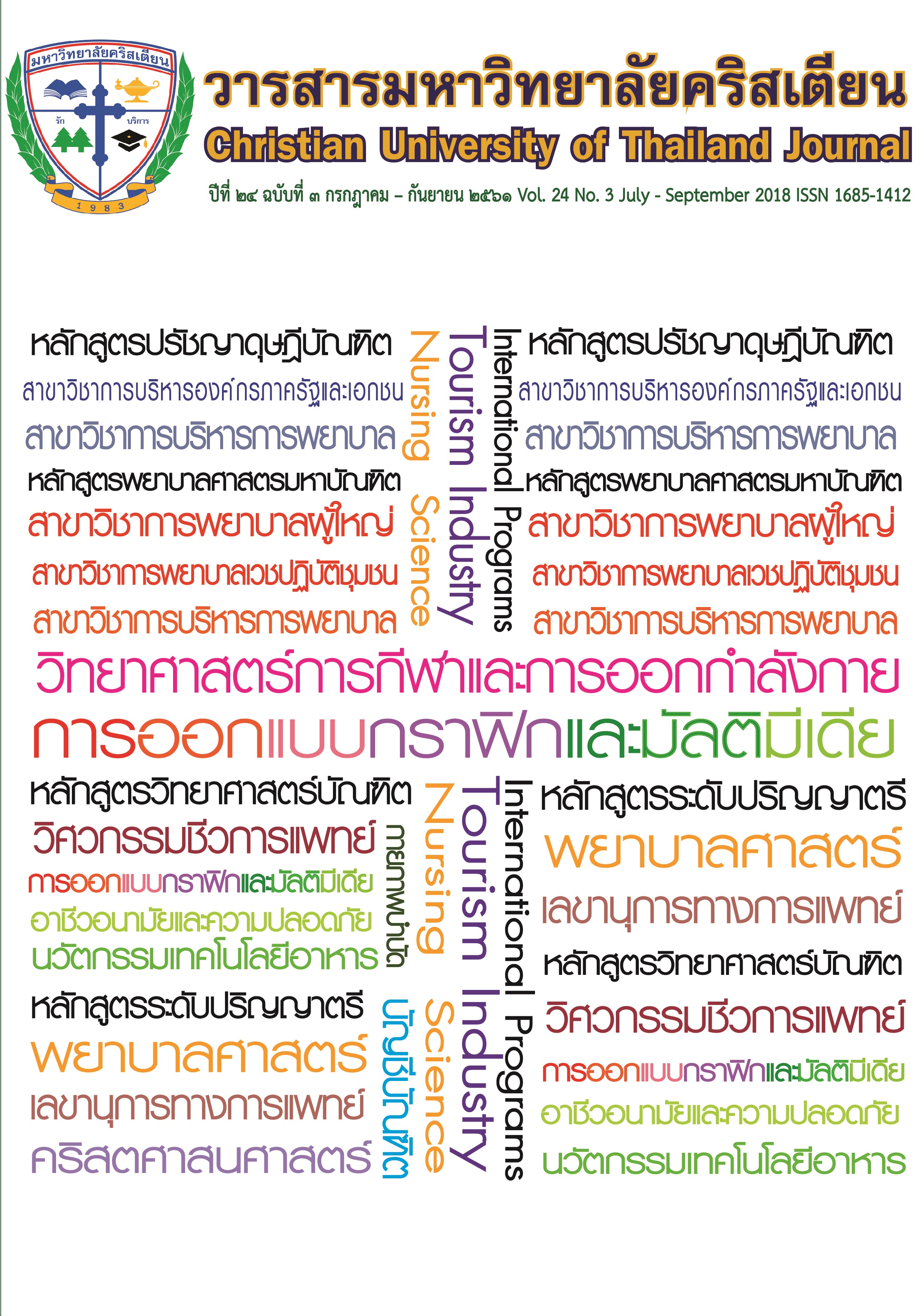ผลของการบริโภคเครื่องดื่มข้าวไรซ์เบอร์รี่ต่อระดับน้ำตาลเฉลี่ยสะสมในเลือด ในผู้สูงอายุที่เป็นโรคเบาหวานชนิดที่ 2
คำสำคัญ:
ข้าวไรซ์เบอร์รี่, ระดับน้ำตาลเฉลี่ยสะสมในเลือด, ผู้สูงอายุ, เบาหวานประเภทที่ 2บทคัดย่อ
งานวิจัยนี้ศึกษาผลของการบริโภคเครื่องดื่มข้าวไรซ์เบอร์รี่ต่อระดับน้ำตาลเฉลี่ยสะสมในเลือด (HbA1c) ในผู้สูงอายุที่เป็นโรคเบาหวานชนิดที่ 2 จำนวน 16 คน มีอายุเฉลี่ย 64.80 8.18 ปี รับประทานยารักษาโรคเบาหวาน กลุ่มซัลโฟนิลยูเรียและเม็ทฟอร์มินอย่างต่อเนื่องแต่ยังไม่สามารถควบคุมระดับน้ำตาลในเลือดได้ โดยกลุ่มตัวอย่างมีค่าเฉลี่ยดัชนีมวลกาย (BMI) 28.10
3.13 กิโลกรัมต่อตารางเมตร และระดับน้ำตาลเฉลี่ยสะสมในเลือด (HbA1c) ร้อยละ 9.45
1.25 ก่อนเริ่มโครงการ ภายหลังการบริโภคเครื่องดื่มข้าวไรซ์เบอร์รี่วันละ 250 มิลลิลิตร ต่อเนื่องเป็นระยะเวลา 3 เดือน ซึ่งเครื่องดื่มมีพลังงาน 51.45 กิโลแคลอรี่สารประกอบแอนโทไซยานินโดยรวม 175 ไมโครกรัม ในรูปของไซยานิดินกับพีโอนิดินและมีความสามารถต้านอนุมูลอิสระโดยรวม (total antioxidant capacity, TAC) ทดสอบด้วยวิธีการวัดค่าความสามารถในการดูดซับอนุมูลอิสระของออกซิเจน (oxygen radical absorbance capacity, ORAC) เท่ากับ 396 ไมโครโมลโทรล็อกซ์ พบว่า HbA1c เฉลี่ยลดลงแตกต่างอย่างมีนัยสำคัญทางสถิติ (p<0.05) (8.63
1.12%) ดังนั้นเครื่องดื่มข้าวไรซ์เบอร์รี่สามารถรับประทานเป็นอาหารว่างระหว่างมื้อเพื่อสุขภาพสำหรับผู้สูงอายุที่เป็นโรคเบาหวานชนิดที่ 2 ควบคู่กับการรักษาทางการแพทย์
References
บุษบา จินดาวิจักษณ์. (2558). ยารักษาโรคเบาหวาน...ใช้อย่างไร. [ออนไลน์]. สืบค้นเมื่อ 6 สิงหาคม 2558,จาก www.phamacy.mahidol.ac.th/knowledge/files/0027.pdf.
รุจิรา สัมมะสุต. (2552). หลักการปฏิบัติด้านโภชนบำบัด. พิมพ์ครั้งที่ 3. ปราจีนบุรี:สุพัตราการพิมพ์.
วิษณุ ธรรมลิขิตกุล. (2556). การวิจัยสมุนไพรทางคลินิก.เวชบันทึกศิริราช. 6(1), 22-32.
สำนักโรคไม่ติดต่อ. (2557). ข้อมูลโรคไม่ติดต่อเรื้อรัง. [ออนไลน์]. สืบค้นเมื่อ 18 ตุลาคม 2557.จาก http://www.thaincd.com/information-statistic/non-communicable-diseease-data.php.
ศุภศิษฏ์ อรุณรุ่งสวัสดิ์. (2558). แอนโทไซยานิน สารพฤษเคมีต้านเบาหวาน. วารสารมหาวิทยาลัยคริสเตียน.21(4), 666-677.
อรุษา เชาวนลิขิต. (2554). การสกัดและวิธีการวิเคราะห์แอนโทไซยานิน. วารสารมหาวิทยาลัยศรีนครินทรวิโรฒ(สาขาวิทยาศาสตร์และเทคโนโลยี). (6), 26-36.
อมรา ทองหงษ์, กมลชนก เทพสิทธา, ภาคภูมิ จงพิริยะอนันต์ และธนวันต์ กาบภิรมย์. (2555).รายงานการเฝ้าระวังโรคไม่ติดต่อเรื้อรัง พ.ศ. 2553. รายงานการเฝ้าระวังทางระบาด วิทยาประจำสัปดาห์.43(17), 257-264. [ออนไลน์]. สืบค้นเมื่อ 2 มีนาคม 2556. จาก http://www.boe.moph.go.th/Annual/AESR2011/index.html.
อัญชลี ศรีจำเริญ. (2556). อาหารและโภชนาการ การป้องกันและบำบัดโรค. พิมพ์ครั้งที่ 3. กรุงเทพฯ:จุฬาลงกรณ์มหาวิทยาลัย.
American Diabetes Association. (2016). Classification and diagnosis of diabetes. Diabetes Care.39(suppl 1), S13-S22.
American Diabetes Association. (2007). Nutrition recommendations and interventions for Diabetes. Diabetes Care. 30(suppl 1), S48-S65.
AOAC.(2012). Official Methods of Analysis of AOAC INTERNATIONAL (2012). 19 ed. Gaithersburg, MD, USA: AOAC international.
Atie-Jafari, A., and et al. (2008). Effects of sour cherry juice on blood glucose and some cardiovascular risk factors improvements in diabetic women-A pilot study. Nutrition and Food Science. 38(4), 355-360.
BAM. (2002). Microbiological Methods & Bacteriological Analytical Manual. [Online].Retrieved October 18, 2015, from http://www.fda.gov/Food/FoodScienceResearch/Laboratory Methods/ucm2006949.htm.
Da Costa, C. T., Nelson, B. C., Margolis, S. A., and Horton, D. (2000). Separation of blackcurrant anthocyanins by capillary zone electrophoresis. Journal of Chromatography A. (799: 1-2), 321-327.
Domingueti, C.P., Dusse, L.M.S., Carvalho, M.D.G., Sousa, L.P.D., Gomes, K.B., and Fernandes, A.P. (2016). Diabetes mellitus: The linkage between oxidative stress, inflammation, hypercoagulability and vascular complications. Journal of Diabetes and Its Complications.(30), 738-745.
Giacco, F., and Brownlee, M. (2010). Oxidative stress and diabetic complications. Circulation Research. (107), 1058-1070.
Hanhineva, K., and et al. (2010). Impact of dietary polyphenols on carbohydrate metabolism.International Journal of Molecular Sciences. (11), 1365-1402.
Ibrahim, M.A., Koorbanally, N.A., and Islam, M. (2014). Antioxidative activity and inhibition of key enzymes linked to type-2 diabetes ( -glucosidase and -amylase).Acta Pharmaceutica. (64), 311-324.
Kahkonen, M.P. and Heinonen, M. (2003). Antioxidant activity of anthocyanins and their Aglycons.Journal of Agriculture and Food Chemistry. (51), 628-633.
Kitabchi, A.E., Umpierrez, G.E., Miles, J.M.,and Fisher, J.N. (2009). Hyperglycemic crises in adult patients with diabetes. https://www.ncbi.nlm.nih.gov/pmc/articles/PMC2699725 Diabetes Care 32(7), 1335-43.
Kongkachuichai, R., Prangthip, P., Surasiang, R., Posuwan, J., Charoensiri, R., Kettawan, A., and Vanavichit,A. (2013). Effect of riceberry oil (deep purple oil; Oryza sativa Indica) supplementation on hyperglycemia and change in lipid profile in Streptozotocin (STZ) induced diabetic rats fed a high fat diet. International Food Research Journal. 20(2), 873-882.
Leardkamolkarn, V., Thongthep, W., Suttiarporn, P., Kongkachuichai, R., Wongpornchai, S., and Wanavijitr, A. (2011). Chemopreventive properties of bran extracted from a newly-developed Thai rice: The Riceberry. Food Chemistry. (125), 978-985.
Li, D., Zhang, Y., Liu, Y., Sun, R., and Xia, M. (2015). Purified anthocyanin supplementation reduces dyslipidemia, enhances antioxidant capacity, and prevents insulin resistance in diabetic patients. Journal of Nutrition. 145(4), 742-748.
Office of the National Economic and Social Development Board. (2017). National Economic and Social Development Plan No. 12, 2017-2021. [Online]. Retrieved February 1, 2018, from http:// www.nesdb.go.th/ewt_news.php?nid=6420.
Ou B., Hampsch-WoodillM.,and Prior, R.L. (2001). Development and validation of an improved oxygen radical absorbance capacity assay using fluorescein as the fluorescent probe. Journal of Agricultural and Food Chemistry. (49), 4619-4926.
Prangthip, P., Surasiang, R., Charoensiri, R., Leardkamolkarn, V., Komindr, S., Yamborisut, U., Vanavichit, A., andKongkachuichai, R. (2013). Amelioration of hyperglycemia, hyperlipidemia, oxidative stress and inflammation in steptozotocin-induced diabetic rats fed a high fat diet by riceberry supplement. Journal of Functional foods. (5), 195-203.
Sancho, R.A.S., and Pastore, G.M. (2012). Evaluation of the effects of anthocyanins in type 2 Diabetes. Food Research International (46), 378-386.
Sports Science and Technology, College, Mahidol University. (2009). BMI: Body Mass Index. [Online]. Retrieved February 9, 2018, from https://ss.mahidol.ac.th/th2/index. php?option=com_k2&view=item&layout=item&id=2&Itemid=136
Stull, A.J., Cash, K.C., Johnson, W.D., Champagne, C.M., and Cefalu, W.T. (2010). Bioactives in Blueberries Improve Insulin Sensitivity in Obese, Insulin-Resistant Men and Women. The Journal of Nutrition. (140), 1764-1768.
Thomas, N., Alder, E., and Leese, G. P. (2004). Barriers to physical activity in patients with diabetes. Postgrad Medical Journal. 80(943), 287-91.
Weisel, T., Baum, M., Eisenbrand, G., Dietrictch, H., Will, F., Stockis, J.P., Kulling, S., R fer, K., Johannes, C., and Christine Janzowski, C. (2006). An anthocyanin/polyphenolic rich fruits juice reduces oxidative DNA damage and increase glutathione level in healthy probands. Biotechnology Journal. (1), 388-397.
WHO.(2016). Obesity and overweight. [Online]. Retrieved March 2, 2013, from http://www.who.int/mediacentre/factsheets/fs311/en/.



